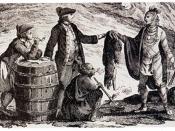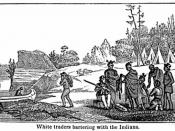The fur trade was a significant part of Canadian history. With the founding of the Hudson's Bay and Northwest Company during the1670's, the fur trade managed growth and development all the way into Western Canada until 1870. The fur trade was unique, for it was the only industry that was based on an exchange of goods between two very different groups of people (namely, the Indians and the Europeans). Although most people think of the fur trade as being a male dominated industry, Indian women also played very important roles in the industry's development. However, the women's experiences differed in relation to the two companies. First of all, they helped foreign European traders by creating cultural liaisons with the Indian traders. Also, they were primarily responsible for maintaining the household. Finally, they were often considered for sexual purposes.
In the beginning of the fur trade, traders were dependent on the Indians for survival.
At that time, it was thought that the Indian wives were "the vogue" during this period. (Kirk, 14) The traders started to marry Indian women because they could learn how to adapt to a native way of life and survival. As a result, it led to "a widespread and complex pattern of intermarriage among fur-trade families." (Kirk, 14) A marriage between a native and a fur trader was a bond that helped to advance trade relations with a new tribe, which created a liaison the traders and her kin. (Kirk, 14) Most women would be their husbands' companion on voyages, and sometimes they would travel alone to sell the furs her husband had trapped. At the same time, "Indian women who married fur traders tried to retain their domestic independences to the same degree as did women in aboriginal households." (Barber, 43) However, this kind of...


